Mitochondrial SLC3A1 regulates sexual dimorphism in cystinuria
IF 6.9
2区 医学
Q1 BIOCHEMISTRY & MOLECULAR BIOLOGY
引用次数: 0
Abstract
Cystinuria is the most common inheritable cause of kidney stone disease, with males exhibiting a higher susceptibility than females. However, the cellular origin and underlying mechanisms of sex differences in cystinuria remain elusive. This study aims to investigate the mechanism using Slc3a1 knockout mice. We found that male mice lacking the Slc3a1 gene exhibited more severe stone formation and renal injuries, unaffected by double knockout of another sex-dependent-expressed cystine transporter Slc7a13 or orchidectomy procedure. Further investigations revealed aberrant mitochondrial functions as the primary factor contributing to the severity of cystinuria in Slc3a1 knockout male mice. Mechanistically, higher SLC3A1 levels in male kidneys could enhance mitochondrial functions through modulation of mitochondrial NAD+ uptake primarily in proximal tubule cells. Supplementation with an NAD+ precursor rescued the sex differences caused by Slc3a1 knockout. Our studies uncover the crucial role of Slc3a1 in mitochondrial functions and provide novel insights into potential interventions for sexual dimorphism of cystinuria.
求助全文
约1分钟内获得全文
求助全文
来源期刊

Genes & Diseases
Multiple-
CiteScore
7.30
自引率
0.00%
发文量
347
审稿时长
49 days
期刊介绍:
Genes & Diseases is an international journal for molecular and translational medicine. The journal primarily focuses on publishing investigations on the molecular bases and experimental therapeutics of human diseases. Publication formats include full length research article, review article, short communication, correspondence, perspectives, commentary, views on news, and research watch.
Aims and Scopes
Genes & Diseases publishes rigorously peer-reviewed and high quality original articles and authoritative reviews that focus on the molecular bases of human diseases. Emphasis will be placed on hypothesis-driven, mechanistic studies relevant to pathogenesis and/or experimental therapeutics of human diseases. The journal has worldwide authorship, and a broad scope in basic and translational biomedical research of molecular biology, molecular genetics, and cell biology, including but not limited to cell proliferation and apoptosis, signal transduction, stem cell biology, developmental biology, gene regulation and epigenetics, cancer biology, immunity and infection, neuroscience, disease-specific animal models, gene and cell-based therapies, and regenerative medicine.
 求助内容:
求助内容: 应助结果提醒方式:
应助结果提醒方式:


